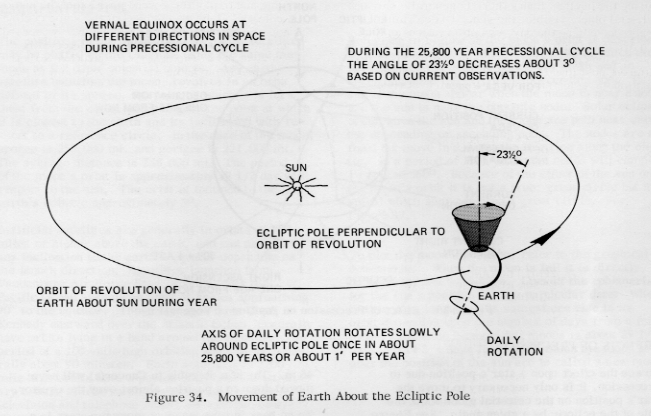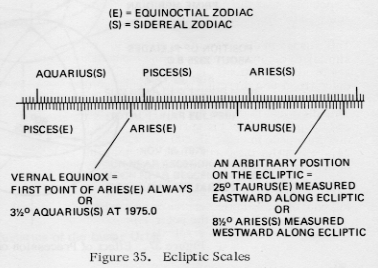

|
Historically, there has been the convention of dividing the ecliptic into 12 regions (Zodiacal Regions) of 30° each and labeling each region with the name of the constellation that falls in that region. About 2,000 years ago, the vernal equinox was between the constellations Aries and Pisces and the vernal equinox was named the First Point of Aries; that is, the position of the sun was just entering Aries at the vernal equinox. At that time, there was the adoption of a division of the ecliptic into twelve 30 degree regions, a division that maintained its relationship to the vernal equinox. Thus, with respect to this new division of the ecliptic, the vernal equinox defined the separation between the two 30° regions called Pisces(e) and Aries(e). Today, some ephemerides are published giving the positions of the sun, moon and planets as so many degrees into Taurus, for example. This is a precise way of specifying positions along the ecliptic with respect to the vernal equinox, but the historical basis of labeling of the regions can lead to confusion, since the statement does not say that the object is near the constellation Taurus. It appears that in the attempt to be precise in the specification of positions along the ecliptic by the introduction of the fixed 30° divisions of the ecliptic with respect to the equinox, one has lost a continuity with the past. A system of time measurement existed that reflected a knowledge of the precession of the equinox and a labeling of the time by the specification of the position of the vernal equinox along the ecliptic (i.e., the age of the Bull, etc.). The Uniglobe uses two notations to specify between the two different divisions of the ecliptic. See Figure 35. |
On the lower scale, along the ecliptic, are twelve divisions with a boundary at the vernal equinox. The divisions are labeled to the east by Aries(e), Taurus(e), etc., where the (e) stands for equinoctial. In this system the vernal equinox is always at the First Point of Aries. On the upper scale is a division of the ecliptic which is considered fixed with respect to the stars. On this scale, the vernal equinox moves to the west and is now at 3 1/2° Aquarius(s). The other regions of the sidereal zodiac are named by the constellations lying in them followed by (s) standing for sidereal. (Note that this is a definition of the fixed or sidereal(s) zodiac with respect to the vernal equinox of 1975.0).  |
|
Page 19 |